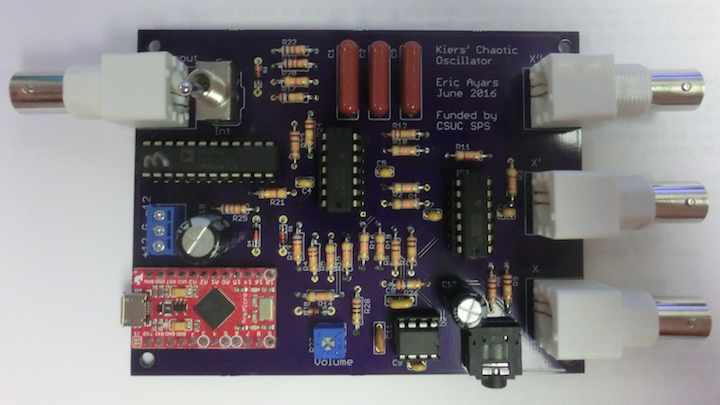Kiers' circuit
This is an electronic circuit that simulates a very basic (minimal) self-driving chaotic equation. No external oscillator source is required, it just oscillates on its own. There is only one adjustable parameter in the equation, which is set by a digital potentiometer. This digital potentiometer is controlled by an Arduino microcontroller, which interfaces to a computer using SCPI-compatible commands. With SCPI commands, the computer user can set resistor values (0-1530) or generate automatic sweeps of resistor values, as well as query the Arduino to obtain current settings.
Depending on the resistor setting, the oscillator output can be stable... or not! Outputs for x, x-dot, and x-double-dot are available, so one can plot the equation trajectory in 3D phase space. Headphone output is available for x, so students can also listen to the output (it's in audio range) and hear bifurcations as secondary harmonics. Poincare plots are not available since there is no external reference drive signal, but one can plot return maps from the data. The circuit is reasonably fast (interesting things happen at 500-1000 Hz) so one can obtain enormous amounts of data with a DAQ card very easily. Interesting investigations could include mapping bifurcations, generating return maps, and determination of Lyapunov exponent at different drive parameters.
In addition, the circuit has an input. In theory, feeding a small amount of the x output of one circuit into the input of the second circuit, when the circuits are on the same resistor setting, should cause the two circuits to synchronize. This promises to be rather interesting, but has not been tested yet!
This circuit was developed by Eric Ayars, from a paper by Ken Kiers, Dory Schmidt, and J.C. Sprott. It works very reliably.

Here is the Schematic for this circuit.
Reading
- Precision measurements of a simple chaotic circuit (Original paper from which the circuit was constructed)
- Read enough of one of the books on chaos in 108 that you know what all the terms in the above description mean.
Questions
- What is phase space?
- What is a return map?
- What are bifurcations, and why are they interesting in the context of chaos?
Experiments
- Develop a LabVIEW program to communicate with the circuit and capture the resulting data. (This is a minimum, obviously!)
- Determine where bifurcations occur, and determine the ratio between successive bifurcations.
- Generate return maps for both low-periodicity and chaotic orbits, and compare them.
- Compare the circuit with a computational model of the same equation.
- Synchronize two of these?
Location
Room 108, drawer 108.12
Hazards
None.